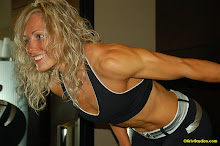Have you ever noticed how some people work out every day and look exactly the same year after year. After investing that much time in the gym, you would think they would be the prime example of a fit and toned physique, yet, they still have those last 10 pounds to lose or a nice round beer belly. Why is their body not adapting from exercise?
It probably is, they are probably more fit than they were when they first walked into the gym. Their muscles and bones may be stronger. Their heart and lungs may function better. They may have reduced their cholesterol levels and risk for heart attack and stroke. They may have better balance, body awareness, and flexibility. In the inside their body is adapting to the exercise...but, why does it not show on the outside?
Most likely diet is to blame. You can put in the hours in the gym, but, if you do not eat properly for your lifestyle, you will never see the rewards of all your hard work. Spend some time talking to a certified dietitian or nutrition coach to find out how much food you should be eating. Every body's needs are different. Once you know how many calories you should be eating, and what foods are the best for getting in those calories, make sure you measure it.
You must become aware of portion sizes to lose weight. Many people eat an excellent, nutritious diet with all the right foods. But, without portion control, too much of even the right foods can make you gain weight.
Try these portion control ideas:
1. Serve yourself measured portions. Use measuring cups and spoons, scales to weigh meats and cheeses.
2. Avoid seconds. Relax and think. Let 20 min. pass before going for the second helping. Chances are, you won't want seconds!
3. Use a smaller dinner plate or dish to satisfy your psychological need to see a full plate. Spread food to cover the plate.
4. Set some food on the side of your plate and leave it behind. Break away from the "clean plate syndrome," the compulsion to eat everything on your plate.
5. Cut food into smaller pieces. It seems like more and the meal lasts longer.
6. Measure cheese and meat to become familiar with 1oz. and 3oz. portions respectively. Measure salad dressings, mayonnaise, peanut butter, and butter in tablespoons to see how much you usually eat and how to "guesstimate". Strive to use 1 tablespoon at most.
7. Measure your glass sizes at home. Is your juice glass 4oz., 6oz., 8oz., or 16oz. ? What about your milk glass??
8. Do you usually eat 1/2 cup, 1 cup, or 2 cups of rice, pasta, or cereal? How much do you need?
9. As time goes on, you will not need to measure everything. You will be a good judge after practicing the first week or month. Then "spot check" yourself now and then to make sure over time you are still eyeballing it accurately.
10. Have the deli attendant slice cheese and cold cuts in 1 oz. slices for your convenience.
11. Buy 3oz boneless, skinless, chicken breasts, etc.
12. Purchase individually wrapped, portion-controlled servings (such as cheese slice "singles" or wedges of frozen dessert bars).
13. Split an entree when eating out. Most are 6-8oz. You probably only need 3-4oz at a meal.
14. Always slice fresh fruit and eat. Slices are more filling than 1 whole fruit.
Choose what You want to do in Life

Quote of the Month
- The Important thing is this: To be able at any moment to sacrifice what we are for what we could become. -Charles DuBois
About Me

- Amy Gilgenbach
- Eden Prairie, Minnesota, United States
- I have been helping people achieve fitness success by incorporating a creative variety of exercises into safe, progressive workouts that target their specific needs. I graduated from the Univeristy of Wisconsin - La Crosse with a degree in sport management and a coaching emphasis. I am a certified personal trainer through The National Strength and Conditioning Association (NSCA-CPT) and the National Acedemy of Sports Medicine (NASM). I compete in state and national level Fitness competitions, earning the title of 'Miss Fitness Wisconsin' on 3 seperate occasions. I know what it takes to convert a worn-out body into an energized, healthy, toned physique and will constantly challenge you to reach your maximum potential.
What are you going to change this week?
I Can Help!
Now that you have set a new goal, you need to tell others so that they can hold you accountable. Checking in weekly with a personal trainer is a great way to stay focused on your goal. They can also offer tips on how to incorporate changes into your lifestyle. If you are not sure what to do, it is time to start working with a certified personal trainer. Get Serious about getting in shape! A personal trainer is a resource for the latest information on health and fitness and can teach you how to make the most out of your time. One-on-One coaching educates, motivates, and challeneges you. A trainer will custom tailor your exercise plan, work around your schedule, add variety, use the latest innovative techniques, and motivate you to be your best. Reach your goals; invest in a trainer.
Contact me today!
Contact me today!
Labels
- Alcohol (1)
- AutoShip (4)
- Calories (2)
- Goals (3)
- Gym Bag Necessities (1)
- Health (2)
- Motivation (10)
- Nutrition (11)
- Recipes (2)
- Sleep (1)
- Stress (3)
- Supplements (7)
- Training (2)
- Water (1)